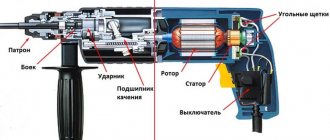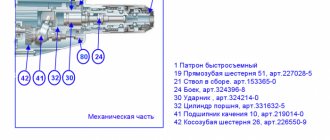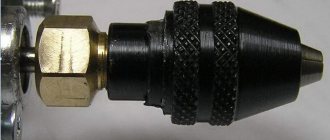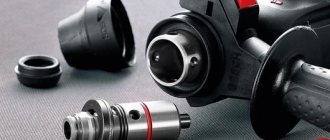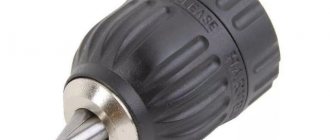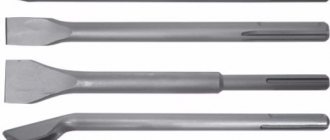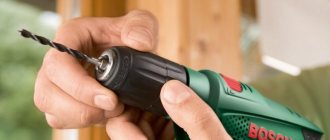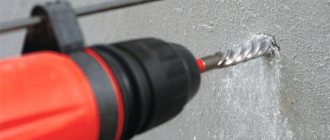A few days ago, a post appeared on our blog about what characteristics a hammer drill for a home should have. One of the selection criteria was the presence of a chuck for SDS Plus type shanks, as the most common. However, in addition to the indicated type of shanks, there are others, which we will talk about today.
First of all, let's find out why SDS shanks were invented. So, SDS shanks were developed by Bosch. The purpose of this development was to create a system for quickly securing drills in rock drills. It is this property of shanks that is encrypted in the abbreviation SDS - Steck - Dreh - Sitzt - “insert”, “turn” and “drill is fixed”. But SDS shanks have another important advantage: the drill can easily move with a certain amplitude along the axis of the hammer drill chuck! And this allows you to protect the cartridge from shock loads and means ensuring its reliable operation for a long time!
Well, now we can talk about the types of SDS shanks, of which there are currently 5 options.
A hammer drill chuck - why is it needed?
Even children know what a hammer drill is. In order for this tool to perform the necessary useful work, an attachment must be installed in the design of the executive body, that is, the cartridge. A power tool, unlike a drill, is capable of not only performing rotational, but also reciprocating manipulations (percussion). Impact movements are needed to resolve issues with such durable types of materials as concrete and reinforced concrete.
The hammer drill chuck serves to secure the attachment and perform the necessary manipulations with the tool. If collet clamping devices are used on drills, then only mechanisms with a special design are used on hammer drills. It is thanks to this specific design that hammer drills are much more effective at processing concrete bases. Externally, the cartridges on the drill and hammer drill are almost identical. The collet mechanism on the drill clamping devices consists of three jaws, which, under the influence of rotational force, are pressed evenly against each other, thereby firmly clamping the cylindrical structure of the attachments. We will find out further how the cartridges on rotary hammers are arranged.
The best SDS PLUS rotary hammers with a vertical engine
Makita HR 2811F
The hammer drill has a power of 800 W and an impact force of 2.9 J. The maximum spindle speed is 1100 rpm, and the blow frequency is 4500 per minute.
Watch the product video
+ Pros of Makita HR 2811F
- Good centering of the drill chuck. When using a drill with a small diameter, there is no axial runout.
- Quite heavy. This can be useful when performing labor-intensive percussion work. Improves productivity.
- Large soft start button. The instrument is sensitive to the operator’s movements and immediately responds to them.
- Long power cable. It is convenient to work with a hammer drill on site.
— Cons of Makita HR 2811F
- The cartridge is the weak point of the model. Some equipment owners replaced it under warranty.
- Difficulty working with one hand. They are explained by the design features of the model and the increased weight.
- Limitation of the use of an additional handle. It is set only at fixed angles.
Conclusion. The model is more suitable for domestic use; with prolonged constant loads, the risk of engine failure increases. It copes well with both dismantling work and drilling and drilling. The increased weight makes it easier to carry out some dismantling work. Spot illumination increases the convenience of drilling and chiseling in low light conditions.
Bosch GBH 3-28 DFR
With an electric motor power of 800 W, the impact force of the hammer reaches 3.1 J. It is capable of working on concrete with a drill with a diameter of up to 28 mm.
Watch the product video
+ Pros of Bosch GBH 3-28 DFR
- Compact dimensions - the tool length is shorter than models with a direct motor.
- Good vibration protection. When chiselling, your hands practically do not feel the blows.
- High power.
— Cons of Bosch GBH 3-28 DFR
- The vertical engine design and hefty weight make drilling and chiseling tasks at heights above shoulder height significantly more challenging.
- During prolonged operation, lubricant scatters from the cartridge. Not practical for use in residential and clean areas
Conclusions. Quite a powerful hammer drill. It is problematic to drill holes with a diameter of 6 mm or less. It copes well with rough work of dismantling brick and concrete structures, as well as drilling/drilling holes in various materials. It is difficult to work with the ceiling for a long time.
The structure of the cartridge
A lot of time has passed since the invention of the rotary hammer, and during this period manufacturers have offered different mechanisms. However, in the end they came to a consensus that the most reliable and effective clamping devices are the SDS type. The cartridges received this abbreviated name due to their ease of use. They were invented by the famous company Bosch, and the hollow name SDS stands for stack-dreh-sitzt. Translated from German - insert, turn and plant.
Design of SDS type cartridges:
- Instead of movable jaws, as on collet devices, splines are used (they are also called rails) and clamps in the form of balls and rollers
- The slots in the chuck mechanism are needed to center the attachment being installed. Also, the slots are responsible for ensuring that the installed attachment, for example, a drill, rotates along with the chuck
- A ball or roller (depending on the type of device) serves to prevent the nozzle from falling out of the cartridge. The use of these clamps allows you to ensure the mobility of the drill, which is important when performing work on drilling concrete surfaces
To understand what kind of device the hammer drill chuck mechanism has, you need to take the nozzle and inspect the tail section.
The photo shows that the drill shank consists of recessed areas called grooves. There are four such grooves on the attachments used for installation in SDS-plus cartridges. Two of them are open type, and two are closed. With open grooves, the drill engages with the splines, and with closed grooves they are secured with balls (there is one ball in the chuck).
Imagining how the cartridge on a hammer drill works, let’s consider what it consists of. It consists of the following parts and elements:
- Axle in the form of a splined bushing
- A ring is placed on the sleeve (3 in the diagram below), which is acted upon by a spring mechanism
- Between the rings and the bushing there are movable locking balls
- To protect the mechanism, the cartridge is covered with a protective casing or cover on top
This type of chuck is called quick-release chuck, and the principle of its operation is to perform the following actions:
- Insert the nozzle with the tail part into the hole of the device
- For seating and secure fixation, it is necessary to act on the device casing, which will compress the springs and ball washers. The ball will “move” to the side and the shank will be seated in place
- The fact that the nozzle has settled into place will be indicated by a corresponding click after the casing is released.
- You can make sure that the part is securely fixed by trying to remove the nozzle. In this case, it will move, but will not fall out of the cartridge
Knowing how a hammer drill chuck is designed (by the way, the design of SDS-plus type equipment is presented above), you can proceed to identifying the types produced by manufacturers. The devices in question for rotary hammers are called not only quick-clamping, but also quick-detachable, since to replace the attachments, you also need to press the cover and remove the installed drill.
What is SDS
SDS (SDS) is an acronym made up of the first letters of the words Steck, Dreh, Sitzt, which translated from German mean “insert, turn, secured.” It is on this simple, but at the same time ingenious principle that the SDS cartridge, developed by Bosch engineers in the 80s of the last century, works. Today, 90% of all manufactured rotary hammers are equipped with these easy-to-use devices, which ensure high reliability of fixing the working tool.
SDS chucks are often called quick-release chucks, but they should not be confused with devices in which clamping is achieved by rotating the couplings. Unlike traditional quick-release chucks, the SDS clamp does not need to be rotated to secure the tool; you just need to hold it with your hand.
To understand the design of a hammer drill chuck of this type, as well as the principle of its operation, just look at the tool shank, which is designed to be fixed in such a device, or the SDS adapter. This shank has 4 grooves, two of which are open at the end of the shank, and the other two are closed. Open grooves act as guides; they ensure the correct position of the tool when it enters the chuck. The closed grooves, in turn, ensure the fixation of the shank in the hammer drill chuck.
Scheme of the impact mechanism of a rotary hammer
In the inner part of the SDS cartridge there are special balls that perform two functions simultaneously. At the moment when the tool is just inserted into the hammer drill, the balls along which the guide grooves move ensure its correct position. After the tool is inserted all the way, such balls fix it, for which it is necessary to turn it a little until the balls enter the closed grooves of the shank. To make using the SDS chuck even easier, it is recommended that the tool shank not only be thoroughly cleaned after each use, but also lubricated.
It should be borne in mind that due to the design features of SDS chucks, the tool that is fixed in them is subject to slight radial runout at idle, which does not in any way affect the accuracy of the processing performed. Meanwhile, the presence of a small play between the shank and the inner surface of the chuck protects the latter from the impact to which drills are exposed during the operation of the hammer drill.
To protect against contamination, all hammer drill chucks are equipped with rubber boots.
Chucks for rotary hammers, their types and distinctive parameters
SDS type chucks are popular, and they are suitable for both drilling concrete and drilling metal or wood. However, clamping equipment of the SDS type comes in different types, and therefore it is necessary to know their features in order to distinguish, for example, when the need arises to buy a chuck for a hammer drill. So, there are these types of chucks for hammer drills belonging to the SDS or quick-release class:
- SDS-plus is a common type of clamps used on household and professional devices. These are predominantly light and medium-heavy units used for use in everyday life and during repair and construction work. The structure of the nozzle shank, which is used for placement in such a cartridge, is described above. In addition, it should be noted that such shanks are 4 cm long and 10 mm thick. Manufacturers produce drills with shanks for this type of clamp with a diameter of 4 to 32 mm
- SDS-max is an analogue of the previous type, only used for more serious high-power tools over 1.2 kW. A distinctive feature of such cartridges is that the nozzles for them have the following dimensions: length 9 cm, thickness 18 mm, and the diameter of the working area reaches 60 mm. If it is necessary to drill a hole larger than 6 cm, then crowns are used. Devices of this type have almost the same shape of grooves as SDS-plus, with only a minor difference - the presence of not two slots, but three. This means that on the shank of the drill being installed there is one open groove, and on the opposite side there are two. Drills and other types of SDS max attachments are used to work with hammer drills with impact forces of up to 20-30 Joules. Rotary hammers with SDS-max chuck are used exclusively for working with the corresponding types of attachments
- SDS-top is a type of chuck that is no longer used, but can be found among owners of outdated tools. Initially they were intended for middle-class hammer drills, that is, for semi-professional models. The thickness of the drill shanks for such clamping devices is 14 mm and the length is 70 mm. In addition, manufacturers produced drills that allow drilling holes from 16 mm. Today, you can find drills and other devices for such hammer drills only in single copies.
- SDS-quick is another classification of rotary hammer cartridges that has not gained wide popularity. Their distinctive feature is that they have a cylindrical shank design, and instead of grooves, there are splines or projections. These types of clamps were developed specifically for Bosch Uneo rotary hammers. Attachments for such hammer drills can even be used on drills and screwdrivers with collet clamps
- SDS-hex is also an experimental modification of the chucks, which were developed specifically for securing lances and chisels in powerful units. However, in addition, the special design of the shanks shows that they are also quite reliable when working with drills
- Spline is a type of cartridge that has some similarities with SDS-max type equipment. Developed in China and produced exclusively for North America. They have a spline design, and the impact movement occurs due to the presence of a seal on the shank of the nozzle
All types of hammer drill chucks are equipped with dustproof covers. All types of clamping devices presented above are used to perform impact actions, which is important when processing concrete. Looking ahead, it is worth noting that collet chucks are also produced for hammer drills, which are used for the purpose when the tool is used more for drilling wood or metal.
Types and scope of application of SDS cartridges
Depending on the diameter of the shank with which the tool or adapter is equipped for fixing it on the hammer drill, SDS chucks are divided into five main types: regular SDS chucks, models of the SDS-top, SDS-quick categories, as well as SDS-plus and SDS-chucks. max. The most popular are the SDS-plus category chucks, which are designed to hold tools with a shank diameter of 10 mm. The shank of the tool, adapted for fixing devices of the SDS-plus category, enters them to a depth of 40 mm. In this case, the diameter of the working part of the tool, which is fixed in SDS-plus chucks, can be in the range of 4–26 mm.
The maximum tool length that can be clamped in SDS-plus chucks is 1 meter, and its most common working diameters are in the range of 6–12 mm. Devices designed to hold SDS-plus shanks and corresponding adapters for rotary hammers in them are used to equip light and medium category equipment, the weight of which, excluding the weight of the tool, ranges from 3 to 5 kg. It is precisely these hammer drills, which are designed for impact loads of up to 5 J, that are most popular among home craftsmen and small repair teams.
Common types of SDS shanks
SDS-max chucks, with a bore diameter of 18 mm, are used to equip heavy professional rotary hammers, whose weight starts from 5 kg. Such hammer drills, which can be used in conjunction with tools with a working diameter of up to 6 mm, are able to create an impact load of up to 30 J. To ensure accurate and reliable fixation of the tool in such serious equipment, an additional guide groove is provided on shanks of the SDS-max category .
SDS-top and SDS-quick chucks are intermediate options for equipping rotary hammers and are used much less frequently than the models described above. Meanwhile, the design of SDS-quick devices, which were developed by Bosch engineers in 2008, is worth a closer look. The tool is inserted into the SDS-quick series chucks not using grooves, but through protrusions on the shank. The design features of SDS-quick chucks allow them to hold tools with a hexagonal shank and a quarter-inch size.
The SDS-quick system is used in Bosch UNEO cordless hammer drills
Removable and non-removable cartridges, what is known about them
When operating a rotary hammer, you have probably come across the term “removable chuck for a rotary hammer”. There are two types of chucks for rotary hammers - removable or quick-detachable and conventional, which are removed only when disassembling the mechanism itself. Quick-release devices are fixed by 4 balls, which engage with the grooves in the end part of the raster sleeve. To remove such a cartridge, you need to pull it towards you.
The photo above shows a removable type device. It can be removed without the need for disassembly. This is very convenient when you need to install a collet element instead. Such devices are not original, so if you come across a new hammer drill with a removable chuck, you need to take this into account, since most likely the clamping mechanism is not original.
Conventional types of clamping devices or original ones can be dismantled only after disassembling the mechanism itself (removable chucks can be installed instead). They are fixed using cylindrical barrels located in grooves.
Mechanisms of the non-removable type are considered reliable, but if it is necessary to replace or repair them, it is necessary to disassemble the equipment. How to remove a non-removable cartridge from a hammer drill is shown in the video below.
This is interesting! The difference in price between replaceable and non-removable cartridges is almost 5 times. If the original element costs about 3-3.5 thousand rubles, then a replacement one can be bought for 500-800 rubles.
What types of cartridges for rotary hammers are there?
In addition to the main types of chucks, additional ones are also produced - key or toothed and quick-clamping BZP. They serve so that cylindrical attachments (from drills) can be installed in a powerful tool for drilling wood or metal. However, their demand decreased after the invention of an adapter from a rotary hammer to a drill with a chuck. This adapter consists of an SDS-plus type shank, as well as a thread onto which the drill chuck is screwed.
Let's look at the features of collet-type clamping devices for rotary hammers:
- A toothed or keyed chuck is a drill chuck that allows installation in a socket with a cylindrical shank. Fixation is ensured using a special slotted key. The key moves the cams, which perform a reliable clamping of the nozzle with a cylindrical shank. The advantage of these devices is that they reliably fix devices with a cylindrical tail section. Such drill chucks also have a drawback - it takes a lot of time to free the drill or, conversely, to fix it
- Quick-release or BZP - should not be confused with SDS quick-release devices. These types of clamps are usually used in the design of screwdrivers. They come in single-coupling and double-coupling types. The nozzle fixation scheme is identical to the key ones, only the quick-clamping ones do not use a key, and hand force is applied instead. More reliable fixation is provided by double-clutch chucks, however, manual clamping does not allow achieving the reliability that is achieved due to the clamping force created by the key
It is not recommended to use power tools with collet clamping mechanisms for impact operations, as they will quickly fail. In addition, it is not recommended to use the hammer drill itself for frequent drilling work when processing wood or metal. For such purposes it is better to use drills. A hammer drill is designed exclusively for working with concrete. Professional models of units do not even have a drilling option, but are only capable of operating in two modes - hammer drilling or drilling and jackhammer. It is rational to buy collet types of devices for a rotary hammer only if the tool is often used for drilling metal and wood, as well as when working with screwing in and unscrewing self-tapping screws, bolts, nuts, etc.
How do chucks for hammer drills work?
To effectively use different hammer drill bits, you need to ensure that they are securely attached. A special cartridge is used for this. Its first models began to be developed back in the 30s of the last century, when hammer drills appeared on the market, the mass production of which was mastered by the world famous company Bosch.
Such a manual device as a hammer drill was almost immediately appreciated by consumers, since it can be used to combine drilling with pulse chiselling, which significantly increases the efficiency of the processing performed. The main drawback of the first models of rotary hammers was precisely due to the fact that the weakest link in their design was the cartridge, which quickly became unusable under the influence of shock loads.
As a result of long-term development, manufacturers of hammer drills and chucks have come to the following conclusion: the simpler the design of the clamping device, the more reliable it is in operation.
Externally, the hammer chuck is a completely closed clamping device
As a result, three main types of cartridges for rotary hammers were created, which in turn are divided into subtypes.
Gear-crown (key)
There are chucks in which the working attachment is fixed using a special key that activates cams that reliably clamp the shank of the tool being used. The most significant advantage of this type of chucks is that they provide reliable fastening of the tool used in conjunction with the hammer drill. Meanwhile, to replace the working tool in such a chuck for a hammer drill, you will need to spend significantly more time than when using other types of clamping devices.
The main types of chucks for rotary hammers
are Quick-release chucks (KLC).
The working attachment of a rotary hammer can be fixed on it using a quick-release chuck (KLC), which is activated only by the force created by the operator’s hands. Depending on the design, cartridges of this type can be single- or double-clutch, the operating principles of which also differ.
Single-socket chucks are easier to use, but they can only be used in conjunction with drills that have the ability to automatically lock the working shaft. To activate such a cartridge, the effort of one hand is sufficient. To use a double clutch clamp, you need to hold the rear clutch with one hand and rotate the front clutch with the other.
Repairing a cartridge or how to remove and replace it
Many owners of this power tool ask how to remove the chuck from a hammer drill. The need arises when it is necessary to replace the fastening device or install a collet element. To remove the cartridge from the hammer drill, you will need to disassemble it. At the same time, during disassembly, you can repair it, so depending on what is supplied, you need to start working. Moreover, the process of how to disassemble a cartridge on a rotary hammer is performed the same for all models:
- Bosch
- Makita
- Interskol
- Metabo
- Caliber and others
Repairing a hammer drill chuck is easy to do with your own hands, and you don’t need to have the appropriate skills to do it. Even a beginner can handle repairing this part, but various signs can serve as a reason for repair:
- The hammer drill chuck does not hold the drill - this means that the ball or rollers have worn out, depending on the type of device. Another reason may be wear of the restrictor ring, as well as sagging of the spring. In any case, you need to figure out how to disassemble the hammer drill chuck in order to identify the exact cause and eliminate it
- The chuck does not hold - the cause of such a breakdown is often the wear of the brackets that attach the device to the tool. Do you need to replace the cartridge on the hammer drill or can you get by with repairs? An autopsy will show, which needs to be done as soon as possible.
Repair of a removable type hammer drill chuck is carried out in compliance with the following sequence of actions:
- At the initial stage, the protective pad is dismantled, which is located at the end or top, depending on the location of the tool. This cover must be pryed off using a screwdriver.
- Then it is necessary to dismantle the retaining ring along with the plate located behind it
- The retaining ring is removed using a screwdriver, with which the boot or cover is fixed
- We dismantle the cover, and now we can assume that the equipment is completely disassembled. At this stage, you can assess the cause of the breakdown and make the necessary repairs.
At this stage, it should be noted that the condition of internal parts is being assessed. Usually identifying a defect is not difficult. Signs of wear can be identified visually, for example, the ring that secures the ball may be worn out.
It should be replaced. To do this, you can buy a repair kit or a separate ring, but it is better to immediately buy all the parts assembled. Next, we will consider the process of assembling a hammer drill chuck, since the question often arises after repairs, how to put the part back together. To do this you need:
- To begin with, all parts that remain old must be thoroughly cleaned of old grease, removing all wear. New lubricant will be added as assembly progresses.
- To begin with, a spring is installed on the barrel
- After this, the plate is installed, which, by the way, was faulty and had to be replaced
- After this, a ball is installed in the hole, having previously lubricated it
- Following the ball, you need to install a thrust ring, as shown in the photo below
- After this, all that remains is to install the housing in place and secure it with a retaining ring.
- Behind the locking ring you need to install a plate holding the boot and secure it with another locking ring
- As a result, the last part is put on - this is the boot.
At this point, the repair process is considered complete. Lubricant is applied in sufficient quantity, and it is better to have too much than not enough. It is recommended to use special lubricants that are used to lubricate drills. Next, all that remains is to install the repaired cartridge in place and check the reliability of the attachments. Below is a video instruction for repairing a hammer drill chuck from Alexander Brest.
Drill chuck for a hammer drill or how to insert a regular drill into a tool
If your hammer drill has a removable chuck, then you can buy an additional collet device with a mount for the hammer drill. If not, then you can use a special adapter, which was already mentioned in the material above. This is a special adapter that consists of an SDS-plus type shank, as well as a thread onto which a regular collet chuck from a drill is screwed. This adapter is inexpensive, and its price is about 50 rubles.
The advantage of such a device is that to install cylindrical attachments, you do not need to remove the standard fastener from the tool. The collet chuck can be removed from the drill and hammer drill. Installing such an adapter will allow you to use a hammer drill for drilling metal and wood with drills with cylindrical shanks.
As a result, it should be noted that the hammer drill chuck is an important element that must always be in good working order. The effectiveness of the tool itself depends on its serviceability. Before inserting the drill into the tool, do not forget to lubricate the shank, since the service life of not only the attachment, but also the parts of the tool itself depends on it. Repair (if the drill does not hold) and removal of a non-removable type cartridge is shown in the video below.
The best SDS PLUS rotary hammers with a horizontal engine
Bosch GBH 2-26 DFR
The hammer drill has 3 operating modes, and its weight is only 2.9 kg. The 800 W motor provides an impact force of up to 2.7 J and allows you to drill holes with a diameter of up to 30 mm in wood.
Watch the product video
+ Pros of Bosch GBH 2-26 DFR
- The model is made of high-quality materials, good assembly pleases.
- Rubberized handles and ergonomics ensure confident operation of the hammer drill.
- Even if your hands are wet, the equipment will not slip. Durability. Many users report reliable operation for 7-10 years. Often the only thing that needs to be replaced is the brushes.
- Power. Concrete with a thickness of 800 mm and grade 350 is not a problem for the GBH 2-26 DFR. The main thing is to periodically lubricate the drills during operation.
- Extended warranty. When registering on the Bosch website, a 3-year warranty is provided.
- Long network cable. Provides freedom of movement when performing work.
— Cons of Bosch GBH 2-26 DFR
- High price. Good German quality along with good components does not allow the model to be sold frankly cheaply.
- Poor equipment. The model comes with a case, interchangeable and quick-release chucks. There are no drills or chisels included as standard.
- Expensive repairs. Over the years of active use, the mechanisms wear out, new German parts are not cheap.
- It's a bit heavy when used as a drill.
Conclusion. The equipment does an excellent job of dismantling and mixing mortars. However, regular use as a mixer or jackhammer will significantly reduce its service life. And Bosch repairs are expensive.
Dewalt D 25134 K
The hammer drill operates in drilling, hammer drilling and chiselling modes. The power of 800 W allows you to drill concrete with a drill diameter of up to 26 mm and make holes in metal with a diameter of up to 13 mm.
Watch the product video
+ Pros of Dewalt D 25134 K
- Smooth speed control. Allows you to ideally configure equipment for processing a specific material.
- Comfort of use. Achieved by a rubberized rear handle.
- It is convenient to drill holes of equal depth due to the inclusion of a depth limiter.
- Operational safety. The safety coupling protects the equipment and the user from jamming of the nozzle.
- Sufficiently high impact force allows you to perform specific tasks.
- Vibration dampening handle. Reduces stress on the hand and allows you to continuously use the hammer drill for several hours.
— Cons of Dewalt D 25134 K
- The operator may accidentally press the release button on the handle.
- The compartment for equipment in the suitcase is not large enough. When going to the site, you need to additionally take a box or bag with drills and chisels.
- Expensive repairs. If the nozzle or cartridge wears out, new accessories will not be cheap.
- The drilling limiter is made of plastic. With constant use with concrete and stone, it quickly loses its visual appeal.
Conclusion. The model copes well with drilling holes and shock loads. It is not recommended to use for mixing solutions. Provides high precision and accuracy of drilling.
Bosch GBH 2-23 REA Professional 611250500
The hammer drill is designed for use in domestic conditions, as well as during repair and construction work. The electric motor power is 710 Watt, the impact force is 2.3 J. It operates in drilling and drilling with impact modes.
Watch the product video
+ Pros Bosch GBH 2-23 REA Professional 611250500
- Ease of use. Light weight makes drilling walls and ceilings as comfortable as possible. The hand practically never gets tired.
- Minimum dust. A standard dust collector removes more than 95% of small particles, making the tool ideal for work in residential areas.
- Good hit. The hammer feels like it hits more than the indicated 2.3 Joules.
- A convenient case provides comfort during transportation.
— Cons Bosch GBH 2-23 REA Professional 611250500
- Expensive consumables (O-rings, filters).
- The need to regularly clean the dust collector cartridge.
- The seal between the body and the filter of the vacuum cleaner fails over time.
Conclusion. The hammer drill is designed solely for drilling holes. Thanks to the dust collector, when working on the ceiling, flying particles of dust and concrete do not fall into your eyes, and debris does not appear in the room. The model is ideal for installing suspended ceilings and other work that requires cleanliness.
Makita HR 2432
Rotary hammer with dust extraction system. Works in 3 modes, allows you to adjust the rotation speed. With a power of 780 W, the impact force is 2.2 J.
Watch the product video
+ Pros of Makita HR 2432
- Effective dust removal. The resulting particles fall into the bag. It can be easily removed and emptied and does not interfere with work.
- Shockproof suitcase. If necessary, you can even sit on it.
- Setting the drilling depth. Allows you to make identical recesses.
- Work safety. After drilling, the drill is placed in the dust container, the user cannot get burned on it.
— Cons of Makita HR 2432
- Large pieces of concrete and brick do not fit into the dust collector.
- The dust collector may interfere with operation.
- A dust spot with a diameter of 30-35 mm forms around the drilled hole.
- Difficult to drill with one hand.
Conclusion. Ideal for indoor work. The dust extraction system ensures cleanliness. All small particles end up in the bag, and not in the operator’s lungs and eyes. The hammer drill is designed for drilling, including impact drilling. It is better not to use it for other purposes.
Bosch GBH 2-28 F
The hammer drill is excellent for drilling and chiselling; it has a chisel rotation function. Increased power of 880 W provides impact force up to 3.2 J.
Watch the product video
+ Pros Bosch GBH 2-28 F
- Precise start of drilling thanks to adjustable speed.
- Comfort of use due to vibration damping system. The hand does not get tired even with prolonged loads.
- High chiseling power and impact force.
- A long cable of 4 meters provides freedom of movement.
- Good punch when chiseling. Effectively performs dismantling work.
— Cons Bosch GBH 2-28 F
- Expensive spare parts; in case of serious damage, it is more advisable to buy a new tool.
- When drilling the ceiling, there is no hiding from dust due to the additional air channel that blows it up.
Conclusion. The model copes well with drilling (including impact) and chiselling. The bit rotation feature allows you to work at different angles. A universal hammer drill that will drill a hole in concrete, drill through metal and perform dismantling work. Has a large reserve of power.
AEG KH 24 IE
With a power of 800 W, the impact force can reach 2.4 J. The light weight of 2.8 kg reduces the load on the hand.
Watch the product video
+ Pros of the AEG KH 24 IE
- Pleasant feeling when working. It doesn’t hurt your hand, it’s pleasant to hold the tool, you can perform operations with one hand. Rubberized handle.
- Great power. Sufficient for deep drilling and dismantling work.
- Ergonomic shape. The reverse switch is conveniently located, so you can change operating modes with one hand without distractions.
- Unprecedented 6 year warranty.
- Reasonable price.
— Cons of AEG KH 24 IE
- Not big enough case with plastic clasps. If you need to take several attachments with you, you have to take additional care of a box or bag for them.
- There is not enough locking click when switching modes. It is not always clear to the operator whether the tool has switched or not.
Conclusion. In practice, the hammer drill copes well with its main tasks - drilling and drilling, as well as with small and medium dismantling loads. Successfully withstands rain, low temperatures and dirt.
Dewalt D 25263K
The hammer drill has a power of 900 W and an impact force of 3 J. It confidently copes with dismantling work and drills and drills holes with good accuracy. Equipped with a safety clutch to protect the user from injury.
Watch the product video
+ Pros of Dewalt D 25263 K
- High precision work. Achieved thanks to an ergonomic additional handle and backlight. The comfortable grip of the main handle makes drilling holes in the ceiling easier.
- Operational safety. The manufacturer has implemented protection against drill jamming; improved design of the air ducts prevents small particles from getting into the operator’s eyes.
- Light load on hands. Moderate weight and anti-vibration system allow the operator to use the power tool comfortably.
— Cons of Dewalt D 25263 K
- Brush motor. At high speeds, brush friction increases, their wear increases, and sparks may appear.
- Insufficient fixation of switching operating modes.
- Insufficient cable length. 2.5 meters is not enough for many to move freely around the work area.
Conclusion. The optimum ratio of price and quality. Excellent drilling parameters, vibration protection system dampens vibrations. The increased power makes the tool an excellent solution for simple dismantling work.
Hitachi DH22PH
The manufacturer offers a lightweight and easy-to-use model. The weight of the hammer drill is 2.1 kg, it fits easily in the hand and provides an impact force of 1.4 J.
Watch the product video
+ Pros of Hitachi DH22PH
- Easy. The light weight of the tool reduces hand fatigue and allows you to work continuously for several hours.
- It has a huge service life and high reliability.
- Ease of use. The ergonomic shape and additional handle make the tool comfortable to use. Thanks to the mode lock button, even long periods of work do not cause problems.
- Smooth speed control. The operator can configure the hammer drill taking into account the material being processed.
— Cons of Hitachi DH22PH
- A cable length of 2.5 meters is not always enough for free movement.
- The case does not have pockets for drills and other attachments.
- The plastic is easily soiled and emits some odor.
Conclusion. One of the best lightweight power tools in its class. It copes well with drilling holes and does it with high precision.
